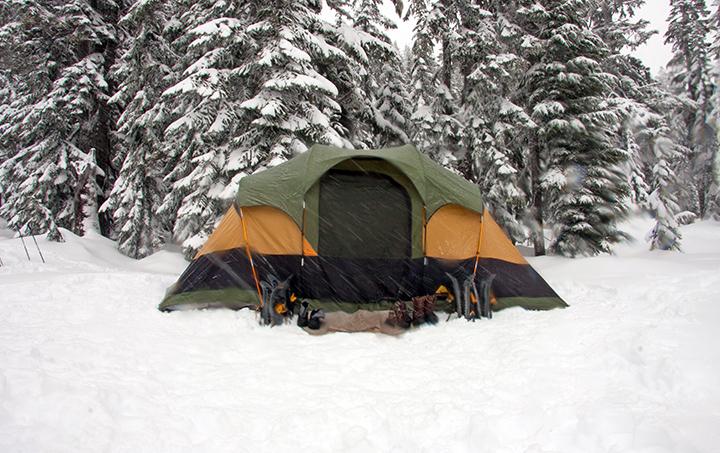 |
|
| Issue #84 • November/December, 2003 |
Hypothermia is a deadly enemy. It steals body heat and kills more outdoor enthusiasts every year than anything else.
Hypothermia is the rapid and drastic chilling of the body’s core temperature (normally 98.6 degrees F) during adverse conditions, and begins when the body loses heat faster than it can be replaced. As the body temperature drops because of exposure to cool air and cold water, things begin to happen in a predictable sequence. Left unchecked, it affects one’s mental condition and physical reactions, and can result in unconsciousness. The ultimate result is death.
While cold rain or wet snow, combined with a brisk wind, create classic conditions, hypothermia is not exclusive to northern winter weather and bitter cold. When water temperatures are 50 degrees F or less, and air temperatures as high as 60-70 degrees F, hypothermia is possible. Given the right set of circumstances, it can (and does) occur anywhere.
Skin, surface fat, and superficial muscle layers act as insulation for the vital organsheart, liver, kidneys, lungs, and the like. As hypothermia takes over, the internal temperature is dangerously lowered creating an extremely serious condition. It quickly leads to mental and physical collapse.
There are two types of this debilitating conditionchronic (long onset) and acute (rapid onset).

Chronic occurs when one is exposed to a cold environment for an extended time, and usually develops in air temperatures between 30 to 50 degrees F. It is commonly associated with winter hikers and backpackers, but can creep up on hunters, cross-country skiers, snowmobilers, and others.
Acute hypothermia happens from sudden immersion in cold water, and depending on the water temperature, can develop from within a few minutes to several hours. Boaters, ice fishermen, skaters, trappers, and those at or on water are often affected by this hazard.
Moisture is the worst enemy in the fight against hypothermia, and gets its start when victims become wet from their own perspiration, a sudden shower, or from an accidental plunge into water.
Protecting yourself
If you slip into cold water from a boat, it is best to get back in or cling to the craft. Staying as far out of the water as possible maintains more body heat, and postpones advanced symptoms. If getting out of the water is impossible, you should be wearing your Coast Guard-approved personal floatation device (PFD) that doubles your chances. A PFD not only helps insulate the body from cold water (reducing heat loss), but lessens the need to move in order to stay afloat.
You can also greatly extend your survival time by assuming the Heat Escape Lessening Posture (HELP) or fetal positionsometimes called the self-huddle. To do this, cross your ankles and bring your knees up toward your chest to protect the trunk of the body. Wrap your arms around your legs just below the knees, cross your wrists, and hold tight.
The greatest heat loss is from the head and neck, and these areas should be kept as high out of the water as possible. The other “hot spots” that lose heat most rapidly are the groin and the sides of the chest. These areas need to be protected the most.
Under hypothermic conditions, avoid the drown-proofing technique as it requires putting your head in the water, and causes you to cool faster than if floating with your head held high.
If there are several people in the water, use the “huddle” method to help each other preserve body heat. Lock your arms around one another and stay side-by-side in a circle.
Swimming to shore can be a deadly decision. The general advice is to stay with a disabled boat. Distances are deceptive, and rescuers can more easily spot a capsized boat than a lone paddler. Swimming burns up body heat, and in 50 degree F water even the best strokers could not make a mile.
Because cold water draws heat from an individual indefinitely, any activity drains the body’s stored energy. Thrashing around creates swirling water, which steals heat from the body more rapidly than still water. Even treading water brings on complications faster. Remaining motionless just about doubles the time a person can endure.
You might be surprised to know hypothermia is the leading cause of death in boating accidents.
The historic sinking of the Titanic in 1912 is a dramatic example of hypothermia’s effect. When the great ocean liner started sinking, passengers put on their PFDs and headed for the lifeboats. When rescue ships arrived two hours later, most of the people in the lifeboats were alive, but none of the almost 1,500 people floating in the 32 degree F water (still wearing those life jackets) lived.
The colder the water and air surrounding a victim, the more sudden and severe the hypothermia. While water will conduct heat away from the body 25 times faster than air of the same temperature, when it is choppy or there are swift currents, along with a blowing wind, the body’s heat will be pulled away 35 times faster. Water chill is much greater than wind chill.
Everyone differs greatly in their ability to survive. Large people with ample body fat cool slower than small, thin people. Women cool more rapidly than men, and children cool the fastest. Of course, health, resistance, and the will to live are all contributing factors.
Treating hypothermia
Any person pulled from cold water or found on land when the classic conditions exist should be presumed to be in trouble. As one’s temperature drops, the heart begins to slow, and the victim becomes weak and confused as less oxygen is delivered throughout the body.
Once the affliction begins, many people are unable to counteract the process by themselves. When the blood to the brain is slowed, the mind fails to function correctly. There are many symptoms, but it is usually the other person who recognizes them in someone having the reactions. Frequently the person experiencing the tell-tale signs becomes too disoriented to realize what is going on.
Ignore protests that everything is okay. Denial of being cold is common, and a hypothermic may truly believe nothing is wrong. Their judgment is impaired. They become drowsy, and usually want to drift off to sleepbut to sleep is to die.
Victims can range from appearing drunk or in a delirium, to acting desperate or combative.
Any of these reactions are probably a signal someone is suffering from hypothermia: difficulty with simple tasks (clumsy actions); dull eyes; listlessness; slurred speech; incoherency; confusion; forgetfulness; fatigue; an inability to control the hands, arms, or legs; stumbling; slow breathing; cold, stiff muscles; uncontrollable shivering or trembling; the stomach cold to the touch; apparent exhaustion; or someone dozing off and being hard to arouse.
Advanced stages of hypothermia render a person unconscious, the skin turns bluish-gray, muscles are rigid, breathing is shallow, and the pulse is weak. Rewarming is crucial, and medical assistance is necessary.
Do’s and don’ts
What to do? Too often people try to help, and invariably do the wrong thing for someone who is hypothermic. There are certain “common sense” things you must not do:
- don’t massage the arms or legs
- don’t raise the legs
- don’t put the person in hot water
- don’t allow any type of exercise
- don’t give alcohol or drugs
- don’t administer hot drinks or hot food
What you should do is promptly get them out of the elements, cover the head and neck to prevent further body heat loss, remove wet or damp clothing and replace it with dry garments, keep the body warm to maintain the vital organs, and handle the person gently. Gentle handling is extremely important so as to not cause ventricular fibrillationa condition when the heart quivers but does not pump blood.
Once it is determined a person is becoming hypothermic, it is essential others offer aid to prevent additional body heat loss. Skin-to-skin contact is an excellent way to transfer body heat. A field measure for rewarming is to remove all clothing and place the victim in a sleeping bag or in a blanket with one or two rescuers who have also removed their clothing.
If this is not possible, build two fires and put the person between them. Even better would be four fires, to surround them with heat.
If the victim appears dead, continue trying to restore body heat. Often hypothermics appear lifeless. Yet, their vital organs continue to functionbut at a much lower rateand they are alive. The medical adage is, “No one is dead until they are warm and dead.”
Ever hear of “after drop?” This occurs with deeply hypothermics after they are moved to a sheltered spot. As a person is rewarmed, the stagnated and cold blood from the extremities returns to the core of the body, dropping the internal temperature even lower. Just as recirculation is started, death may occur.
When this happens, the official cause is frequently listed as something other than hypothermia. Those in cold water lose control of their arms and legs and drown, while those on land die of heart failure. Sometimes death is listed as “due to exposure,” yet the real reason was hypothermia.
Prevention
|
Instead of hoping you’ll be clear-headed enough to recognize the symptoms, know enough to prevent them. There are a number of things you can do.
When heading outdoors during questionable weather, dress properly. Several layers of loose clothing are better than tight clothes, and wool clothing traps body heat even when wet. Mittens are always warmer than gloves. Because much of the body’s heat is lost through the head, a hat, cap, or stocking pullover will trap heat and allow your body to send more warm blood to your hands and feet. Most important, stay dry and change clothes if they become damp or wet.
One of the best safeguards against hypothermia is to eat hot meals and drink warm liquids before going out. This provides the nutrition and fuel your body needs to stay warm. In the field do not allow yourself to become dehydrated, and keep nibbling on high-energy snacks to help maintain body heat.
If weather conditions worsen, seek shelter wherever possible, and protect yourself from the wet, wind, and cold.
The best preventive maintenance against hypothermia is awareness. Everyone should put on rain gear before getting wet. For insurance, an extra set of clothing should be with you, in the camper, or at least nearby.
Outdoor enthusiastswho frequently believe they are tougher than the other guyshould be able to recognize in advance the conditions that lead to the problem, and take the necessary precautions to avoid trouble. The savvy person also must be able to spot the warning signs in others in their group.
You don’t have to be in the wilds of Hudson Bay, on the Alaskan tundra, or in a Montana blizzard to succumb to hypothermia. Given the right circumstances, you can become a victim in the Everglades of Florida, on the southwest deserts, or in (or out of) a rowboat on a favorite lake.
Hypothermia doesn’t just happen to the other guy. We all need to know the danger signs.














